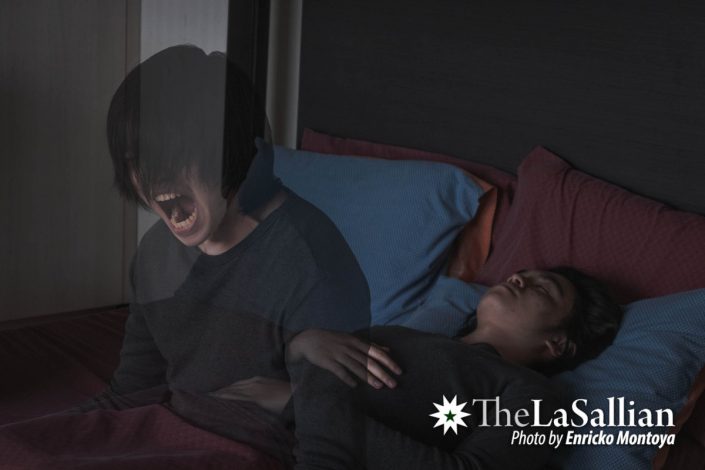As a period of rest, sleep ought to be the least of our concerns. While quality sleep can improve our well-being, a lack of or poor quality sleep does the opposite. There are some people, however, who have experienced waking up enveloped in fear, unable to move or speak. Some may even report that they catch glimpses of supernatural entities during these episodes. This condition is known as sleep paralysis.

What’s happening to me?
Dr. Patrick Gerard L. Moral, an adult pulmonologist, sleep specialist, and teaching assistant at the University of Santo Tomas, describes sleep paralysis as the inability to move or speak during sleep.
He highlights two important stages of sleep: the rapid eye movement (REM) and the non-rapid eye movement (NREM) stages. NREM encompasses three substages where the body and mind transition from wakefulness to sleep. REM, on the other hand, is the stage where people begin to dream—this is where sleep paralysis occurs.
Moral also says that “it’s in the REM part where our breathing becomes irregular and our brain becomes less susceptible to input,” causing patients to feel out of breath during sleep paralysis episodes. These symptoms normally go unnoticed while we sleep, but people who experience sleep paralysis regain consciousness during this period and become aware of their surroundings.
He posits that sleep paralysis is common in sleep-deprived individuals who suffer from sleep disorders like insomnia—a sleep disorder where people experience difficulty sleeping—or have poor sleep schedules. These people experience “sleep-onset REM periods” in which they immediately transition to REM without undergoing NREM.
Medical literature characterizes sleep paralysis as either isolated or recurring. While isolated sleep paralysis is independent of any underlying medical conditions, recurring sleep paralysis is related to underlying conditions like narcolepsy—a chronic sleep disorder characterized by excessive bursts of drowsiness especially at daytime—and involves recurring episodes.
The many faces of fear
Other than the aforementioned symptoms, patients also report experiencing hypnagogic hallucinations, which occur as a person falls asleep. There are three types of hypnagogic hallucinations often associated with sleep paralysis. These three are “intruder”, “chest pressure”, and “vestibular-motor” hallucinations.
Intruder hallucinations involve sensing a presence within the room during a sleep paralysis episode. On some occasions, this presence can intensify, manifesting into a multisensory hallucination of a physical entity.
On the other hand, chest pressure hallucinations, also known as “incubus” hallucinations, involve feelings of suffocation. This type is characterized by breathing difficulties, which are often associated with demonic figures such as incubi or succubi sitting atop a person’s chest. In some cases, chest pressure hallucinations may occur alongside intruder hallucinations.
Lastly, vestibular-motor hallucinations feature illusory activities, such as flying, floating, or falling. Some people who suffer from vestibular-motor hallucinations may also describe out-of-body experiences where they observe themselves from an external perspective.
Looking at numbers
To gain a more personal understanding of sleep paralysis, The LaSallian conducted a survey about the condition. Of the survey’s 37 respondents, 19 confirmed that they had previously experienced sleep paralysis.
While they had varying descriptions of their own sleep paralysis episodes, the most common involved visualizing demonic figures and feeling suffocated—the intruder and chest pressure hallucinations previously mentioned. Diane* (II, HUM-BIO) describes their experience as feeling air being blown into their ear and sensing someone holding their back on another instance.
Some participants also attribute their episodes with physical and emotional states. Aly* (III, MKT) mentions that they stopped experiencing episodes when they shifted degree programs and went where they felt more comfortable, while Chin* (V, ChE) states that their sleep paralysis episodes occured when they were experiencing emotional distress.
Ultimately, it is hard to get a grasp of the prevalence of sleep paralysis. Moral reasons that patients rarely complain about the condition until it develops chronicity or becomes bothersome. Generally, such concerns are raised by people whose work schedules are demanding, such as medical practitioners, healthcare workers, and students.
Moral also brings forward the possibility that the COVID-19 pandemic is exacerbating sleep paralysis cases. With quarantine restrictions set in place, many were forced to adopt work-from-home setups. As such, in addition to being a place of rest, our homes now double as workplaces.
A good night’s sleep
Since sleep paralysis is mainly caused by sleep disruption and poor pre-bedtime habits, the condition is remediable. “One of the basic treatments for this would be sleep hygiene,” Moral advises. Sleep hygiene simply refers to healthy sleep habits such as observing a regular sleep schedule, limiting pre-bedtime alcohol consumption, and maintaining a comfortable sleep environment.
Despite being accompanied by cultural connotations of spirits or demons, sleep paralysis is nowhere near supernatural. Our current understanding of it establishes that it is nothing more than a temporary disconnection of the waking mind from the sleeping body. “Sleep paralysis can be terrifying, but it will not kill you,” Moral reminds. If you ever suffer from sleep paralysis, a quick visit to a sleep specialist may help, especially if the episodes become bothersome.
*Names with asterisks (*) are pseudonyms
